step 0 :creating a fragment, other files
create fragment.xml, fragment.java extending fragment and inflate layout in onCreateView().(for both fragments)
public class Frag_b extends Fragment {
public Frag_b() {
// Required empty public constructor
}
@Override
public View onCreateView(LayoutInflater inflater, ViewGroup container,
Bundle savedInstanceState) {
// Inflate the layout for this fragment
return inflater.inflate(R.layout.fragment_frag_b, container, false);
}
}
step (1) Dynamic Fragments:
As we know when an app launches, the androidOS first calls the activity to show up(the one having "android.intent.action.MAIN" permission ). So to display a fragment in runtime we use a class called FragmentManager(Read more about its features here.So, to attach a fragment:
1 - create global objects of both the fragments and fragment manager in main activity.
2 - create global fragment tags : they are very important for restorability of same fragment objects.They will be used as tags to access/ identify strings.
3 - addition via fragment manager: So here comes the first use-case of fragment manager : to add fragments dynamically(at run time). here is the code for it:
public class MainActivity extends AppCompatActivity implements FragAHandler,FragBHandler {
LinearLayout layRoot;
FragmentManager manager=getSupportFragmentManager();
public static final String FRAG_A_TAG="FRAG_A";
public static final String FRAG_B_TAG="FRAG_B";
@Override
protected void onCreate(Bundle savedInstanceState) {
super.onCreate(savedInstanceState);
setContentView(R.layout.activity_main);
layRoot=findViewById(R.id.layout_root);
manager.beginTransaction().add(R.id.layout_root,new Frag_a(),FRAG_A_TAG).commit();
manager.beginTransaction().add(R.id.layout_root,new Frag_b(),FRAG_B_TAG).commit();
}
}
step 2 Fragment Communication:
As indicated here, fragment communication is a 4 layered process:
* An interface defines the functions(the task that fragment wants to perform).
* The activity implements them.
* The fragment gets an instance of this interface(in the form of activity's context).
* Fragment uses this instance according to its need .
{in case of fragment-fragment communication , 2 more small steps are added to it}:
* the fragment sends a signal to activity.
* the activity then handles the signal and sends it to other fragment.
Thus if a fragment FragA wants the main activity to show notification on a button click(present inside fragment ):
- create an interface FragAcall having function void showNotif().
- Implement it in MainActivity.(and define whatever you wish that your activity should perform on receiving click from fragment A .i.e, showing a notification).
- In fragA create an object of interface FragAcall (FragAcall callObj).
- In fragA, override a method named onAttach(context).cast this context to FragAcall' Object.
- Inside your button's on click listener, call callObj.showNotiff().
similarly for a 2 way fragment-fragment communication, I implemented the code using these steps:
* created interfaces FragAHandler and FragBHandler:
public interface FragAHandler {
void addFrag1();
void closeFrag1();
}
public interface FragBHandler {
void addFrag2();
void closeFrag2();
}
implement these in main activity:
public class MainActivity extends AppCompatActivity implements FragAHandler,FragBHandler
{
LinearLayout layRoot;
FragmentManager manager=getSupportFragmentManager();
public static final String FRAG_A_TAG = "FRAG_A";
public static final String FRAG_B_TAG = "FRAG_B";
@Override
protected void onCreate(Bundle savedInstanceState) {
super.onCreate(savedInstanceState);
setContentView(R.layout.activity_main);
layRoot = findViewById(R.id.layout_root);
manager.beginTransaction().add(R.id.layout_root, new Frag_a(), FRAG_A_TAG).commit();
}
@Override
public void addFrag1() {
if (manager.findFragmentByTag(FRAG_A_TAG) == null) {
manager.beginTransaction().add(R.id.layout_root, new Frag_a(), FRAG_A_TAG).commit();
} else {
Toast.makeText(MainActivity.this, "frag1 Already present", Toast.LENGTH_SHORT);
}
}
@Override
public void closeFrag1() {
Frag_a fragA = (Frag_a) manager.findFragmentByTag(FRAG_A_TAG);
if (fragA != null) {
manager.beginTransaction().remove(fragA).commit();
} else {
Toast.makeText(MainActivity.this, "frag1 Already not there", Toast.LENGTH_SHORT);
}
}
@Override
public void addFrag2() {
if (manager.findFragmentByTag(FRAG_B_TAG) == null) {
manager.beginTransaction().add(R.id.layout_root, new Frag_b(), FRAG_B_TAG).commit();
} else {
Toast.makeText(MainActivity.this, "frag2 Already present", Toast.LENGTH_SHORT);
}
}
@Override
public void closeFrag2() {
Frag_b frag_b = (Frag_b) manager.findFragmentByTag(FRAG_B_TAG);
if (frag_b != null) {
manager.beginTransaction().remove(frag_b).commit();
} else {
Toast.makeText(MainActivity.this, "frag2 Already not there", Toast.LENGTH_SHORT);
}
}
}
In this code manager.findFragByTag() is being used to check weather a fragment is already being displayed or not,since we only want to open one single instance of the other fragment. for its detailed use, see this
Inside fragments, attach the mainActivity's class context to your handler obj and use it inside buttons:
public class Frag_a extends Fragment {
FragBHandler fragBHandler;
public Frag_a() {
// Required empty public constructor
}
@Override
public void onAttach(Context context) {
// context is the activity's context.
super.onAttach(context);
try {
// This makes sure that the container activity has implemented
// the callback interface. If not, it throws an exception
fragBHandler = (FragBHandler) context;
} catch (ClassCastException e) {
e.printStackTrace();
Log.e("", "onAttach: class has not implemented fragAhandler");
}
}
// THIS SHOULD NEVER BE AN APPROCH.
// public Frag_a(FragBHandler fragBHandler) {
// this.fragBHandler = fragBHandler;
// }
@Override
public View onCreateView(LayoutInflater inflater, ViewGroup container, Bundle savedInstanceState) {
// Inflate the layout for this fragment
View v = inflater.inflate(R.layout.fragment_frag_a, container, false);
v.findViewById(R.id.bt_open_frag2).setOnClickListener(new View.OnClickListener() {
@Override
public void onClick(View v) {
openFrag2();
}
});
v.findViewById(R.id.bt_close_frag2).setOnClickListener(new View.OnClickListener() {
@Override
public void onClick(View v) {
closeFrag2();
}
});
return v;
}
public void closeFrag2() {
fragBHandler.closeFrag2();
}
public void openFrag2() {
fragBHandler.addFrag2();
}
}
VOILA ,BOTH FRAGMENTS CAN LITERALLY TALK NOW!
**Part 3: Fragment Duplication **
this was one of the most difficult task.up till now, my aim to create an app with 2 fragments communicating was complete .But when i rotated my phone, there was a major fail: whatever that was present on the screen was being created multiple times!

I found the solution by doing the following things:
- Using one common object for both frag1 and 2 that are created during onCreate(), and that too by checking if it is already present in the back-stack, then using that object only to add again.
- Adding the initial fragment also after checking the back-stack.
So my final for mainActivity code becomes:
public class MainActivity extends AppCompatActivity implements FragAHandler, FragBHandler {
LinearLayout layRoot;
FragmentManager manager = getSupportFragmentManager();
Frag_a fragmentObjA;
Frag_b fragmentObjB;
public static final String FRAG_A_TAG = "FRAG_A";
public static final String FRAG_B_TAG = "FRAG_B";
@Override
protected void onCreate(Bundle savedInstanceState) {
super.onCreate(savedInstanceState);
setContentView(R.layout.activity_main);
initialise();
if (manager.findFragmentByTag(FRAG_A_TAG) == null && manager.findFragmentByTag(FRAG_B_TAG) == null) {
//both are imp because of testcase not giving exact answer:
// >>>open app: shows frag1>'press open frag2'>>>frg2 opens >'close frag 1' >>> rotate.
//Expected output >> "fragment 2(already present object in backstack and on screen) to remain on screen
//output recieved : both frag 1 and frg2 showing
manager.beginTransaction().add(R.id.layout_root, fragmentObjA, FRAG_A_TAG)
.setTransitionStyle(FragmentTransaction.TRANSIT_ENTER_MASK)
.commit();
} else {
Toast.makeText(MainActivity.this, "frag1 Already present or fragment 2 present", Toast.LENGTH_SHORT).show();
}
}
private void initialise() {
layRoot = findViewById(R.id.layout_root);
if(manager.findFragmentByTag(FRAG_A_TAG)!=null){
fragmentObjA= (Frag_a) manager.findFragmentByTag(FRAG_A_TAG);
Log.e(">>", "initialise: frgement A object recieved from the frag manager is used" );
}
else{
Log.e(">>", "initialise:new frag a object created" );
fragmentObjA=new Frag_a();
}
if(manager.findFragmentByTag(FRAG_B_TAG)!=null){
fragmentObjB= (Frag_b) manager.findFragmentByTag(FRAG_B_TAG);
Log.e(">>", "initialise: frgement B object recieved from the frag manager is used" );
}
else{
Log.e(">>", "initialise:new frag object created" );
fragmentObjB=new Frag_b();
}
}
//-----------handler methods-------------------
@Override
public void addFrag1() {
if (manager.findFragmentByTag(FRAG_A_TAG) == null) {
manager.beginTransaction().add(R.id.layout_root, fragmentObjA, FRAG_A_TAG)
.setTransitionStyle(FragmentTransaction.TRANSIT_ENTER_MASK)
.commit();
} else {
Toast.makeText(MainActivity.this, "frag1 Already present", Toast.LENGTH_SHORT).show();
}
}
@Override
public void closeFrag1() {
Frag_a fragA = (Frag_a) manager.findFragmentByTag(FRAG_A_TAG);
if (fragA != null) {
manager.beginTransaction().remove(fragA)
.setTransitionStyle(FragmentTransaction.TRANSIT_EXIT_MASK)
.commit();
} else {
Toast.makeText(MainActivity.this, "frag1 Already not there", Toast.LENGTH_SHORT).show();
}
}
@Override
public void addFrag2() {
if (manager.findFragmentByTag(FRAG_B_TAG) == null) {
manager.beginTransaction().add(R.id.layout_root, fragmentObjB, FRAG_B_TAG)
.setTransitionStyle(FragmentTransaction.TRANSIT_ENTER_MASK)
.commit();
} else {
Toast.makeText(MainActivity.this, "frag2 Already present", Toast.LENGTH_SHORT).show();
}
}
@Override
public void closeFrag2() {
Frag_b frag_b = (Frag_b) manager.findFragmentByTag(FRAG_B_TAG);
if (frag_b != null) {
manager.beginTransaction().remove(frag_b)
.setTransitionStyle(FragmentTransaction.TRANSIT_EXIT_MASK)
.commit();
} else {
Toast.makeText(MainActivity.this, "frag2 Already not there", Toast.LENGTH_SHORT).show();
}
}
}




